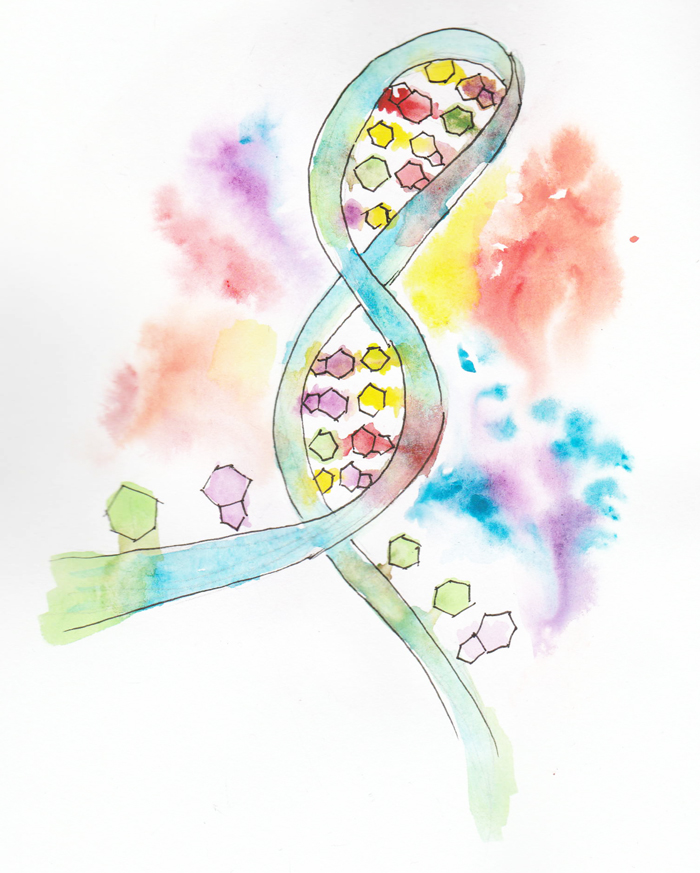Through mathematical modeling and collaboration with scientists at the University of California San Francisco (UCSF), McGill researchers, including Rached Alkallas, graduate student in the Department of Human Genetics and the primary author of the seminal study published in Nature Communications, have identified a protein that sharply decreases in patients with Alzheimer’s disease (AD). They then created an algorithm to track the production of this protein by using mRNA.
In cells, proteins are only produced when they are needed; otherwise, they degrade. For example, when taking a bite of chocolate cake, the human body responds to the increase in blood-sugar levels by producing insulin, a protein which helps transform sugar to energy. The insulin level rises when sugar has to be taken up, and falls back when no sugar is circulating throughout the bloodstream. After blood-sugar levels return to normal, insulin will be chopped down by some cellular machinery.
The amount of messenger RNA, or mRNA, limits the amount of protein that can be produced. mRNA copies codes of genetic material from DNA, which is then used to instruct protein production in the cell.
Imagine hundreds of construction workers with one physical blueprint of the building at hand; their work progress would be unbearably slow. However, if every worker had a blueprint, their productivity would increase. The same goes for mRNA; the more mRNA, the more proteins can be synthesized. Proteins and microRNAs, short strands of RNA that chop slice mRNA, regulate the amounts of mRNAs.
The McGill researchers found proteins and microRNA that can stabilize the mRNA of synaptic proteins in the brain. Synaptic proteins allow neurons to have an easier time communicating with each other by facilitating the release of important proteins at appropriate times.
“[We identified six different proteins], consisting of microRNAs and proteins, that are involved in shaping the mRNA stability profile of the brain,” Alkallas said. “[RBFOX, one of the proteins, turned out to be] dysregulated in the brains of patients with AD.”
Quantifying the amount of mRNA in tissue samples is technically challenging. The researchers therefore resorted to a roundabout route; by using public data on mRNA abundance—called “RNA-Seq data”—they built a mathematical model to predict mRNA stability. Researchers at UCSF measured the rate of mRNA degradation in cells that they had grown, and the McGill team then found that their predicted values from the model matched to the values obtained at UCSF.
“[UCSF] helped us to test the validity of our theoretical model in living systems,” Alkallas said.
After the confirmation of their model, Alkallas and his colleagues used it to analyze the RNA-seq data from two different populations of humans—a control group and patients who died from AD—and pinpointed RBFOX’s rapid degradation in the brain tissues of Alzheimer’s patients. The protein RBFOX is important to stabilize mRNAs of proteins that facilitate synaptic transmission. The decreased amounts of RBFOX result in destabilizing the mRNA, leading to a reduced ability to send nerve signals—a symptom of AD patients.
“We propose that dysregulation of RBFOX is associated with an altered mRNA stability profile in AD, opening the door to further research on the potential role of RBFOX in AD [progression],” Alkallas said.
There are two main implications of this study. First, other researchers can use the model to study proteins that regulate mRNA stability without actually measuring the amount of mRNA. Second, the researchers found a marker for AD diagnosis—downregulation of RBFOX, potentially leading to loss of brain functions.
The next step of the study is finding a way to stabilize RBFOX to keep the neural connectivity in AD patients robust, and to employ the mathematical model in cancer research, not just in the field of neurological diseases.
“[We would like to] characterize the mRNA stability profiles of human cancers and [determine] the protein and mRNA factors that shape these profiles,” Alkallas said. “We also hope to determine if any such factors drive cancer aggression.”
The research groups at McGill and UCSF combined neuroscience and mathematics to quantify the amount of mRNA, and identified a protein that is downregulated in AD patients.
Normally, you would expect researchers to isolate tissue samples from patients and collect mRNA and proteins instead. This study illustrates how collaborative the research community has become.






